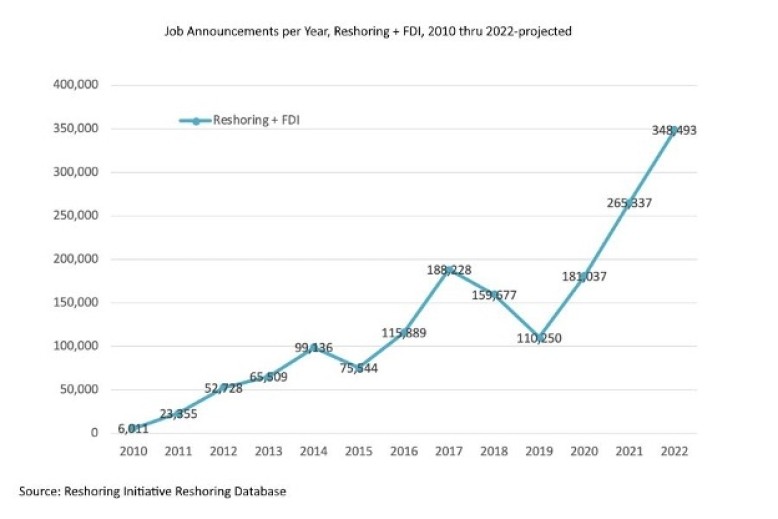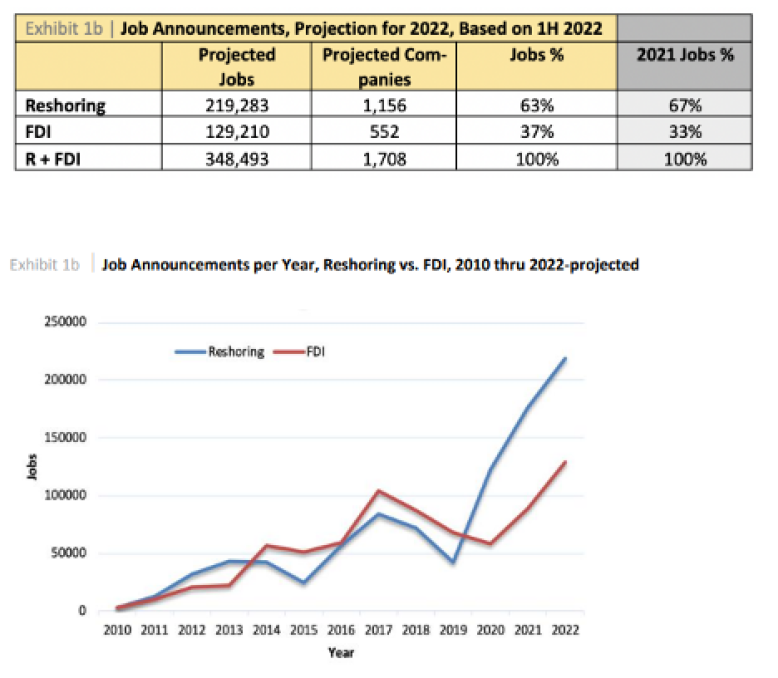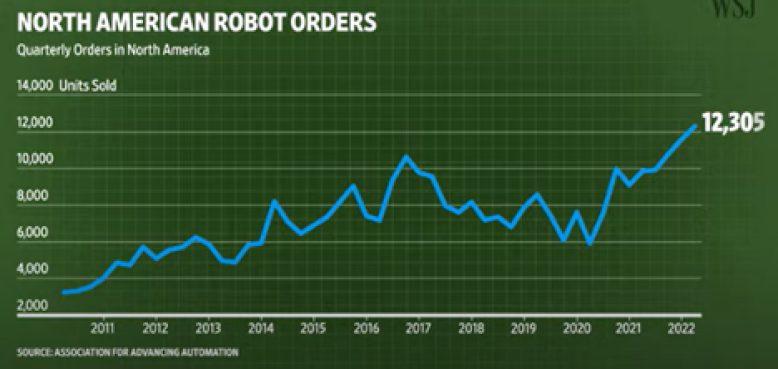US Manufacturing “Reshoring” Faster Than Ever: The good news and the bad (but fixable) news
For decades the US (and other industrial nations) have sent manufacturing operations overseas where labor is cheap, environmental rules different, and other financial benefits helped with overall profitability. While this may have made financial sense at the time, the model is broken. Tariff wars, a global pandemic with resulting catastrophic supply chain impact, global tensions and other factors have shown how vulnerable these policies have come. Not to mention the major reductions of US manufacturing labor force. Manufacturing is coming back to local soil at record pace in efforts to remedy this.
Current 2022 projections (source: Reshoring Initiative) show a record 350,000 jobs added back to US soil. 1.6M jobs since 2010! And for the 3rd year in a row, US-specific returning jobs is exceeding “Foreign Direct Investment” or FDI – non-US-based companies adding factories and jobs inside the US. This is clearly a boon for US manufacturing as well as the overall economy – especially long-term.

Chart from Reshoring Initiative Reshoring Database showing the massive growth of reshoring and FDI.

Data showing the breakdown of reshoring vs. FDI.
Why are we seeing these records shattered?
Bringing back US manufacturing jobs has been a goal of the US government going back many administrations – truly a bi-partisan initiative. Each president has introduced continued assistance (“Made In America” Act, boosting technical education programs and others) and it is starting to pay off. Combine this with world events that have reshaped the operational, environmental and political landscape we are witnessing a torrent of US reshoring and FDI like we have never seen.
Major impacts specifically in the last 4-5 years:
- 2019 “trade wars” – creating tariffs to incentivize builds in the USA
- COVID-19 pandemic completely shocks the supply-chain creating unprecedented challenges for manufacturers – around the globe
- Global tensions across nations create uncertainties in overseas production and sourcing.
- US legislation such as Infrastructure Bill, CHIPS act, Inflation Reduction Act, Made in America Act and others create incentives for local sourcing and manufacturing.
- Environmental, Social and Governance requirements – manufacturers and related business doing their part to make the planet and its inhabitants better off.
While we all want to see well-paying jobs in our home country - helping provide for families and grow local economies – there are challenges. Our current labor markets are already majorly strained with lack of qualified workers and rising wages – a major challenge. North American manufacturers are purchasing robots and automation is at record levels – many of the manual or assembly-type jobs that left for cheap labor markets have a small likelihood to come back as they once were. This new level of automation will create many better paying and more skilled jobs for many Americans with the hope off offsetting those losses.

Association for Advancing Automation showing increase of robots and automation.
Bringing back manufacturing to US soil assumes that our higher US wages, overhead and other costs will create higher price tags for consumers and not be as competitive. This is a legitimate concern, but today’s companies (at least the smart ones) are utilizing readily available technology and tools to run their operations “lean” to keep costs at a level where products remain reasonable.
Industry 4.0 is a huge part of this. Technology such as 3D-printing (additive manufacturing), the Internet of Things (“IoT” helping factories significantly reduce profit-killing unplanned downtime), powerful yet easier-to-use and affordable software solutions including EAM and CMMS help keep costs under control. This gives US companies the ability to remain competitive – both here and around the world.
One example of many: unplanned asset downtime is a “profit killer”. Manufacturers that have an excellent ratio of preventive and predictive maintenance vs. reactive (“break then fix”) have lower costs and greater profitability. IoT platforms such as Brightly Smart Assets that can easily attach sensors to any asset, production line or facility to track metrics such as vibration, pressure, temperature and more. These sensors then alert maintenance of potential failures when those problems are minor. These IoT capabilities enhance EAM and CMMS tools, such as Brightly Asset Essentials, work to automate and improve maintenance operations – especially with work order management. This can avoid disruptive unplanned downtime, improve quality, boost team morale and safety among other benefits. All of this helps control costs and keep these now-local manufacturers in-line within their markets.
I have been studying and working in the manufacturing world for decades. The technology revolution we are witnessing, combined with national push to call our factories back home is incredibly exciting! It won’t be easy. We need more qualified workers, smarter factories and technology to keep our firms competitive globally. The available IoT and software tools are just what you need to get started and begin operating “lean”.




